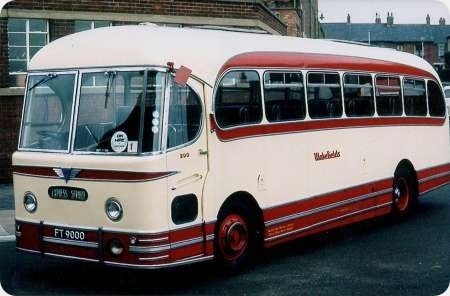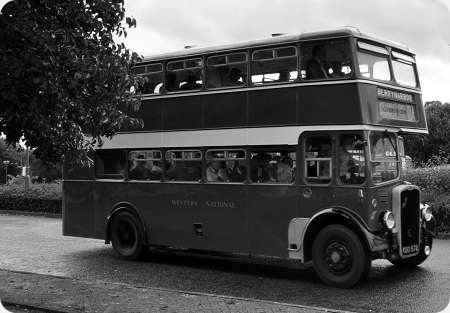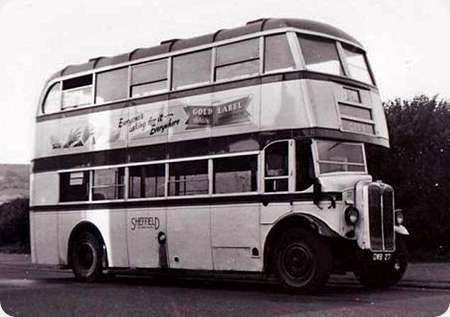
Copyright Unknown
Sheffield Corporation
1937
AEC Regent I
Weymann H55R
Quite a few of Sheffield’s Regent 1 intake of 1937/8 with both original and rebuilt bodies survived up to around 1960 with the majority being withdrawn in the late 1940’s and early 1950’s. One such survivor was No. 27 registration DWB 27, a Weymann bodied H55R example. This machine was new in 1937 and survived until 1958 in original form. To achieve 21 years in normal service in Sheffield’s hilly terrain was no mean feat and unsurprisingly at the time of withdrawal, 27 was one of Sheffield’s oldest service buses albeit probably mainly used on peak time extras and school runs in later life.
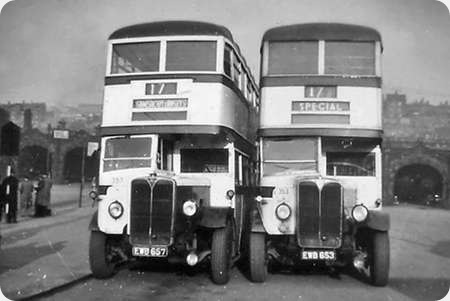
Copyright John Darwent
More Regent 1 examples of a somewhat more modest lifespan were No. 357 registration EWB 657 and 353 registration EWB 653 both of 1938 vintage with Cravens H55R bodywork pictured here in 1953 at Sheffield Midland Station between duties. I am unsure whether 353 had been modernised in some way as there is a difference in appearance between the vehicles and I have another image of 353 showing sliding toplights on both decks of a later era than the drop down windows of other Cravens vehicles of the batch.
Photograph and Copy contributed by John Darwent
21/08/14 – 09:08
With the exception of the war-time Corporation (Queens Road) bodied Regents, these were the only pre-war Regents not bodied by Weymann. I was eight in 1960 but do not remember seeing any pre-war AECs in service – apart, possibly, from the Roe re-bodies. 657 is a Cravens in original condition, 653 at the very least has a modified front if not totally rebuilt.
This area in front of Midland Station was until the early 1950s used by C fleet routes (out of town) and possibly some B fleet as well. Buses awaiting service were parked, like 653 and 657, against the pavement which divided the area from the road.
David Oldfield
21/08/14 – 10:57
Lovely photos of the Regent I which always make my heart beat a little faster! Why is there a space fillet between body and rad on 27? Was a slightly shorter body fitted later or what? I imagine it wasn’t re-engined with a Gardner 6LW engine!!!
Photo 2 shows the typical unmatching front wings, so prevalent at this time! I also notice that the matching height headlamps lf 353 do not apply to 657.
Chris Hebbron
21/08/14 – 12:45
Sheffield continued to specify the 8.8 litre engines after the "7.7" had become standard. Maybe this explains the space fillet.
David Oldfield
21/08/14 – 15:28
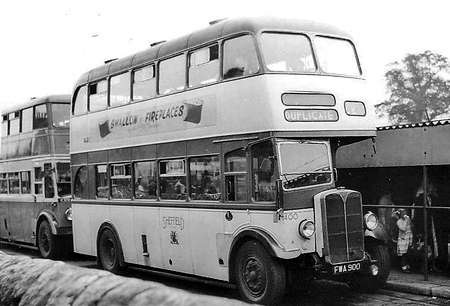
Copyright Unknown
I think the radiator fillet was a general feature on all the Regent 1’s Chris, even the Roe rebuilds.
John Darwent
22/08/14 – 06:42
The extended bonnet as seen on these Sheffield Regents was standard for the 8.8 litre engine. This originally was the A165 indirect injection unit, but later, under pressure from the LPTB, became the A180 direct injection motor with Leyland style pot cavity pistons. The 6LW was even longer than the AEC 8.8, as may be seen on pictures of the London LT types and Huddersfield Regals so fitted. I suspect that the Sheffield examples were of the 8.8 indirect injection variety. Incidentally, I am intrigued by the picture of the two Regents parked side by side. How on earth did the driver of EWB 653 get out of the cab?
Roger Cox
22/08/14 – 08:20
Aye, there’s a bit of Sheffield black magic there, Roger.
The Roe re-build bodies replaced Cravens bodies – which were, I would guess, of suspect build quality. This might also explain the modification/rebuild of 653.
David Oldfield
22/08/14 – 18:11
Good point re the driver’s door Roger. I have examined the original photo taken with my highly unsophisticated Brownie 127 way back when and there is no trickery. Another photo of 353 reveals an ordinary opening door – no sliding conversion – of course, if the cab had similar characteristics to my old Austin Mini, then the driver could have exited through the floorpan!
John Darwent
22/08/14 – 18:11
Well, either he got out before EWB657 reversed into place (people sometimes do that to me in supermarket car parks!) – or, to misquote the famous Yorkshire tale, "Ee, ‘e were thin!"
Stephen Ford
23/08/14 – 16:32
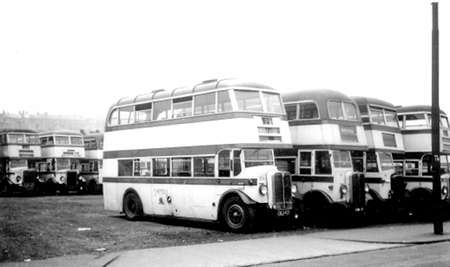
Copyright Unknown
Here’s an eclectic selection of Sheffield Corporation gems dominated by Regent 1’s, seen on the Pond Street bus park in the early 50’s.
Featuring;
306 – 1938 Regent 1/Weymann CWJ 406
471 – 1941 Regent 1/Northern Counties HWA 51
496 – 1944 Daimler CWA6/Duple
4 – 1938 All Leyland TD5c EWJ 304
438 – 1940 Regent 1/Weymann GWE 658
474 – 1942 All Leyland TD7 HWA 384
John Darwent
29/08/14 – 15:25
I used to live by Brammall Lane, but went to school at Anns Rd. Heeley. To go to school I had a choice of 33 Hemsworth, (Regent 3 Cravens bodywork), 34 Graves Park, (Regent 3 Northern Coachbuilders), 35 Hollythorpe Rise, (Regent 3 Weymann). All had pre selector gearbox.
However, there was a duplicate route 36 to Heeley Green. This was the original route of 1913, extended to Graves Park in 1926. You could have single, double decker’s or lowdeckers, pre or post war. It did not have a destination name, as these were all removed in WW2, & after that, there was no such route.
The reason I loved this route so much, was it had to make a steep hill start at Anns Road stop. If it was not a pre selector box but a crash box, I would stay on the bus to Heeley Green. They would set off in 1st, but by the time they engaged 2nd,the bus had come to a stop. They then repeated the process many times to get to the top of the hill. I chuckled inside, many of the conductors also, as the driver got more & more frustrated. It made me late for school. Of course I blamed the buses for making me late, but it was worth it.
Would someone explain how the pre selector box works please?
Andy Fisher
29/08/14 – 15:28
Andy To start with try this. it may be a bit slow to load.
Peter
